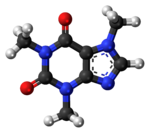咖啡因
咖啡因(粵拼:gaa3 fe1 jan1,化學式:C8H10N4O2)係種黃嘌呤類生物鹼,亦係世界上最廣泛使用嘅中樞神經興奮劑。過60種植物嘅果同葉道都有咖啡因,其中常見嘅包括咖啡、茶同唂咕三個屬嘅植物。提取植物入面嘅咖啡因經常用浸出嘅方法。提純好嘅咖啡因係白色固體,有啲苦。
| 咖啡因 | |
|---|---|

| |

| |
| IUPAC名 1,3,7-trimethylpurine-2,6-dione (1,3,7-三甲基嘌呤-2,6-二酮) | |
| 別名 | 1,3,7-三甲基黃嘌呤 咖啡鹼 |
| 識別 | |
| CAS號 | 58-08-2 |
| SMILES | n1(C)c(=O)n(C)c2ncn(C)c2c(=O)1
|
| KEGG | D00528 |
| 性質 | |
| 化學式 | C8H10N4O2 |
| 摩爾質量 | 194.19 g·mol−1 |
| 外觀 | 白色結晶 |
| 密度 | 1.23 g/cm3 |
| 熔點 | 235至238℃[1][2] |
| 如果無講明,所有數據都係指25 °C,100 kPa嘅時候嘅情況。 | |
咖啡、茶、唂咕同埋功能飲料入面都有咖啡因。FDA將咖啡因歸入GRAS一類,即係一般都認為係安全。成年人每日攝入10克咖啡因先會中毒,爾個遠遠高過正常攝入量(每日500毫克以下)。
咖啡因對產生佢嘅植物有三個作用:蟲食咗有咖啡因嘅葉或者果之後會麻痹,所以咖啡因有殺蟲作用;啲葉同果跌落地之後會令到啲泥道都有咖啡因,噉樣其它植物種子就生長唔到;咖啡因可以令蜜蜂之類傳播花粉嘅蟲有更多後代。
藥物作用
編輯少少嘅咖啡因有解除疲勞同興奮神經嘅作用,但係攝入過多會造成心律失常、消化道潰瘍,甚至令下一代出現智力低下、肢體畸形等人體損害[3],亦會上癮;上癮之後一停食就會冇乜精神、周身疲勞。
有關嘅書
編輯- Bersten, Ian (1999). Coffee, Sex & Health: A history of anti-coffee crusaders and sexual hysteria. Sydney: Helian Books. ISBN 0-9577581-0-3.
{{cite book}}: CS1 maint: ref duplicates default (link) - Pendergrast, Mark (2001) [1999]. Uncommon Grounds: The History of Coffee and How It Transformed Our World. London: Texere. ISBN 1-58799-088-1.
{{cite book}}: CS1 maint: ref duplicates default (link)
出面網頁
編輯- GMD MS Spectrum
- The Consumers Union Report on Licit and Illicit Drugs, Caffeine-Part 1 Part 2
- Caffeine: ChemSub Online
- Caffeine at The Periodic Table of Videos (University of Nottingham)
- Caffeine International Chemical Safety Cards
- Mayo Clinic staff (3 October 2009). "Caffeine content for coffee, tea, soda and more". Mayo Clinic. 喺8 November 2010搵到.
註
編輯- ↑ "Caffeine". Pubchem Compound. NCBI. 喺16 October 2014搵到.
Boiling Point
178 deg C (sublimes)
Melting Point
238 DEG C (ANHYD) - ↑ "Caffeine". ChemSpider. Royal Society of Chemistry. 喺16 October 2014搵到.
Experimental Melting Point:
234–236 °C Alfa Aesar
237 °C Oxford University Chemical Safety Data
238 °C LKT Labs [C0221]
237 °C Jean-Claude Bradley Open Melting Point Dataset 14937
238 °C Jean-Claude Bradley Open Melting Point Dataset 17008, 17229, 22105, 27892, 27893, 27894, 27895
235.25 °C Jean-Claude Bradley Open Melting Point Dataset 27892, 27893, 27894, 27895
236 °C Jean-Claude Bradley Open Melting Point Dataset 27892, 27893, 27894, 27895
235 °C Jean-Claude Bradley Open Melting Point Dataset 6603
234–236 °C Alfa Aesar A10431, 39214
Experimental Boiling Point:
178 °C (Sublimes) Alfa Aesar
178 °C (Sublimes) Alfa Aesar 39214 - ↑ 〈新型毒品防範手冊之(二)〉。《中華人民共和國公安部》。2006年6月23號。原著喺2016年3月4號歸檔。喺2015年7月10號搵到。
- ↑ "Caffeine: Summary of Clinical Use". IUPHAR Guide to Pharmacology. The International Union of Basic and Clinical Pharmacology. 喺13 February 2015搵到.
- ↑ Gupta, V; Lipsitz, LA (October 2007). "Orthostatic hypotension in the elderly: diagnosis and treatment". The American Journal of Medicine. 120 (10): 841–7. doi:10.1016/j.amjmed.2007.02.023. PMID 17904451.
- ↑ Mathew OP (2011). "Apnea of prematurity: pathogenesis and management strategies". J Perinatol. 31 (5): 302–10. doi:10.1038/jp.2010.126. PMID 21127467.
- ↑ Kugelman A, Durand M (2011). "A comprehensive approach to the prevention of bronchopulmonary dysplasia". Pediatr Pulmonol. 46 (12): 1153–65. doi:10.1002/ppul.21508. PMID 21815280.
- ↑ Schmidt B (2005). "Methylxanthine therapy for apnea of prematurity: evaluation of treatment benefits and risks at age 5 years in the international Caffeine for Apnea of Prematurity (CAP) trial". Biol. Neonate. 88 (3): 208–13. doi:10.1159/000087584. PMID 16210843.